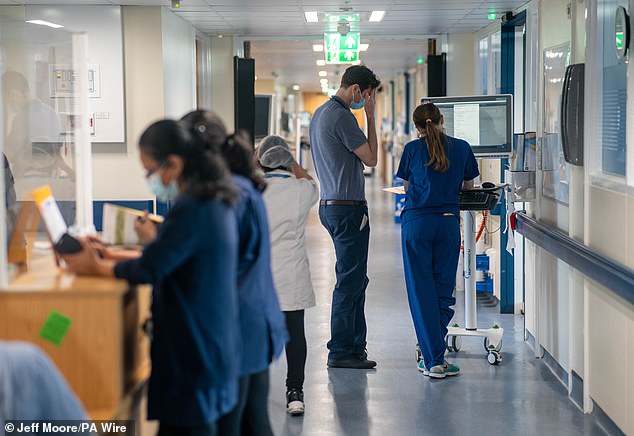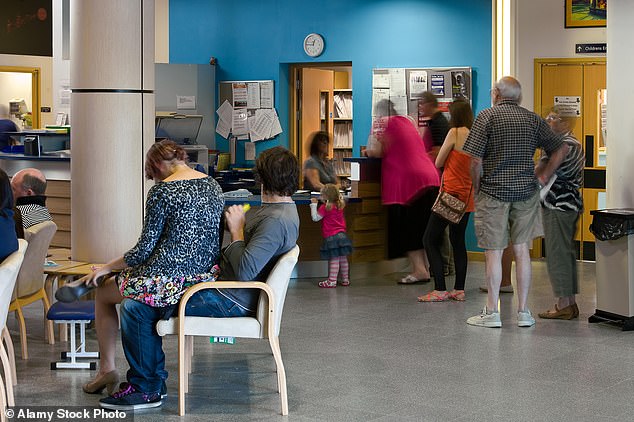Not long ago, I proposed creating a quiet room for patients with learning disabilities and autism in the urgent care department of the busy London hospital where I’ve worked for the past few years.
Alongside my colleagues, I’ve had to deal with spiralling numbers having screaming meltdowns in the frenetic and chaotic environment of A&E.
It had become clear that a simple, calm space where people with special needs could wait without becoming overwhelmed would be a huge help.
It should have been easy. There was one room that, with a lick of paint and a few cheerful posters, would easily fit the bill.
Except that this is the NHS, and what should have been a straightforward process became an exercise in bureaucratic absurdity.
No quick Google to hire a decent, cost-effective decorator here. Instead, after assorted safety checks, consultations with approved contractors and multiple layers of management, we were told that a room that could have been ready in 24 hours at a cost of a few hundred pounds would cost £6,000 and take two weeks.
The result? It didn’t happen, after management ruled they didn’t have £6,000 to spare – something I could have told them without writing up one of the 50-page reports that always accompanies such decisions.
And so the patients for whom we had tried to provide something humane and helpful had to continue to wait, overstimulated and frustrated, because the system could not accommodate something so basic.

Not long ago, I proposed creating a quiet room for patients with learning disabilities and autism in the urgent care department of the busy London hospital I work in. It should have been easy -but this is the NHS so it became an exercise in bureaucratic absurdity. Pictured: File photo
I wish this was an isolated incident. But I can tell you that one room, and that small, thwarted attempt by doctors to make care more compassionate, illustrates the single biggest problem faced by the NHS today.
It’s not, as so many people believe, rising immigration, ageing populations or ever more complex health needs, although they all contribute to the ever-mounting pressure on the system.
It is the suffocating grip of red tape which wraps itself round every element of life on the NHS front line.
And deployed via an army of middle managers – many on fat salaries – who have never so much as changed a dressing, yet who are present in hospitals and medical centres around the country to such an extent that, in the words of Lord (Stuart) Rose, the NHS is ‘drowning in bureaucracy’.
That, incidentally, was in 2015, when the former Marks and Spencer chief executive undertook a review of NHS leadership.
His withering conclusion led to much bluster about efforts to reduce the bureaucratic burden on NHS organisations.
But I can tell you that, ten years on, the situation is worse not better – and patient care is deteriorating.
Take something as seemingly trivial as changing a lightbulb. Not complicated ones, we’re talking a flickering 60-watt affair. Most of us have got one in a kitchen drawer at home, but woe betide the exasperated medic or consultant who brings one in and tries to replace that solitary flickering overhead hospital light.
Instead, forms must be filled, and ‘estates’, procurement, and commissioning bodies are involved, turning something that should cost about 50p into a complex, ludicrously expensive project.
This would all be frustrating enough – a mindless, unnecessary waste of money that could be better spent on actual care – but the obsession with procedure and box-ticking is not just bureaucratic folly. It creates catastrophic problems for those charged with delivering care.
Most managers are not medically trained and cannot grasp the pressures faced on the ‘shop floor’.
Six-figure salaries may be common, but understanding of what it means to work on the front line is rare. And patients pay the price.
Take an average day in A&E. Hour after hour, sometimes minute by minute, ambulances arrive at busy departments all over the country, with patients in need of urgent attention.
These patients should be the priority, but managers are more preoccupied with meeting handover targets and do so whatever the human cost.
Today, hospitals are penalised if handover takes too long, and more than once I’ve seen managers demand that a patient be moved from a bed before it is safe, citing penalties and targets.
Just recently one colleague, a paediatric registrar, had picked up the red ’emergency’ A&E phone, which rings to inform medics that someone is being ‘blue-lighted’ to the unit.

I wish this was an isolated incident. But I can tell you that one room, and that small, thwarted attempt by doctors to make care more compassionate, illustrates the single biggest problem faced by the NHS today – the suffocating grip of red tape. Pictured: File photo
Just as she hung up, she turned to find a manager at her shoulder insisting that another of her young patients be relocated instantly or they would be in breach of managerial targets of being seen, treated, admitted, transferred or discharged within four hours of arrival.
The child was unsafe to move, but managerial targets leave no room for discretion, even when the consequences can be grave. Their focus is not on the patient, but on their flow charts.
I cannot overstate how stressful – or how dangerous – it is for a doctor who is moments away from dealing with an emergency arrival to have to argue about this.
My colleague stood her ground, but was so upset at being treated like an obstacle when she was trying to save lives that she subsequently raised a complaint about the manager’s behaviour.
Shift work compounds the problem. Patients and illness do not adhere to a schedule, and none of us, shaped by the guiding principle ‘first do no harm’, will abandon a patient we are treating because our watch tells us our shift is over. If care extends beyond your hours, you cannot walk away.
Yet today, the hospital may refuse support if anything goes wrong and they consider you to have been working ‘out of contractual hours’.
It means that notes, once a way to communicate clinical decisions, have become legal shields.
Like all of my colleagues, I spend hours crafting referrals or documenting procedures for my own protection, only to be criticised for taking too long.
Meanwhile, foreign-trained nurses face months or years of registration paperwork before they can deploy their skills where needed, while GPs spend hours on non-clinical administrative forms.
Appraisals meant to assess professional development have become exhausting paperwork marathons.
IT systems require duplicate entries and endless data requests: one 2020 review found that a third of a community clinician’s time is consumed by administration rather than patient care – 88 working days lost each year.
Those are days, weeks, months, that could be spent healing the sick. We all know what this translates into.
I’ve written before about the dystopian scenes in many of our hospitals, where corridors have become de facto wards in which patients are stationed on trolleys, and staff have to deploy valuable energy appeasing managers, navigating forms and second-guessing actions that should be instinctive.
Perhaps the ultimate irony is that where a degree of bureaucracy might actually help it is conspicuous by its absence.
Take parking. Doctors pay to park, often spending half an hour or more circling the hospital for one of a tiny number of designated spaces for which they must then fork out up to £20.
I know of nurses paying for expensive Ubers because they can’t guarantee being able to park and don’t want to walk the streets in the dark to get to their car after a late shift.

All this has consequences beyond mere fatigue. Burnout is rampant. Doctors and nurses, unable to reconcile professional values with the constraints imposed upon them, are leaving the NHS in record numbers. Pictured: File photo
This is where middle managers could do something useful, by expanding staff parking and – God forbid! – making it free.
Alas, that would mean losing lucrative revenue from the visitor parking fees so it’s a case of ‘computer says no’.
Food is a further indignity. Today there are limited staff messes, no on-call rooms, no designated quiet spaces to eat or write notes.
Many is the time that after a gruelling shift I’ve had to content myself with a lone chocolate bar from a corridor vending machine because bureaucracy has no interest in staff well-being.
Instead, the human needs of doctors – the very people keeping the system alive – are invisible to a system that treats us as machines, expecting us to work extended hours while also holding us accountable for the natural consequences of exhaustion.
I can’t help noticing too, that where all those flow charts and ‘systems’ and ‘frameworks’ – and all the other jargon beloved by the suit and tie brigade – could help, they are nowhere to be seen.
Winter is coming, the system is already groaning under the pressure, yet there is no talk of preparation or sourcing of funding to help the inevitable strain that will be coming our way.
All of this has consequences beyond mere fatigue. Burnout is rampant. Doctors and nurses, unable to reconcile professional values with the constraints imposed upon them, are leaving the NHS in record numbers, taking with them their knowledge and judgment and creating staff shortages that only add to the spiralling pressures faced by those left behind.
The grim reality is that the profession I love is being hollowed out by process and policy.
If we do not address it urgently, we risk losing what makes the NHS extraordinary. Not the buildings, not the policies, not the contracts – the people.
The NHS is broken because the people who should be empowered to care are shackled by rules, targets and management structures.
If we are serious about saving it, we must strip away the red tape, trust the clinicians and put patient care first.
Ideally, too, we would be able to change a lightbulb without filling in a 50-page form.